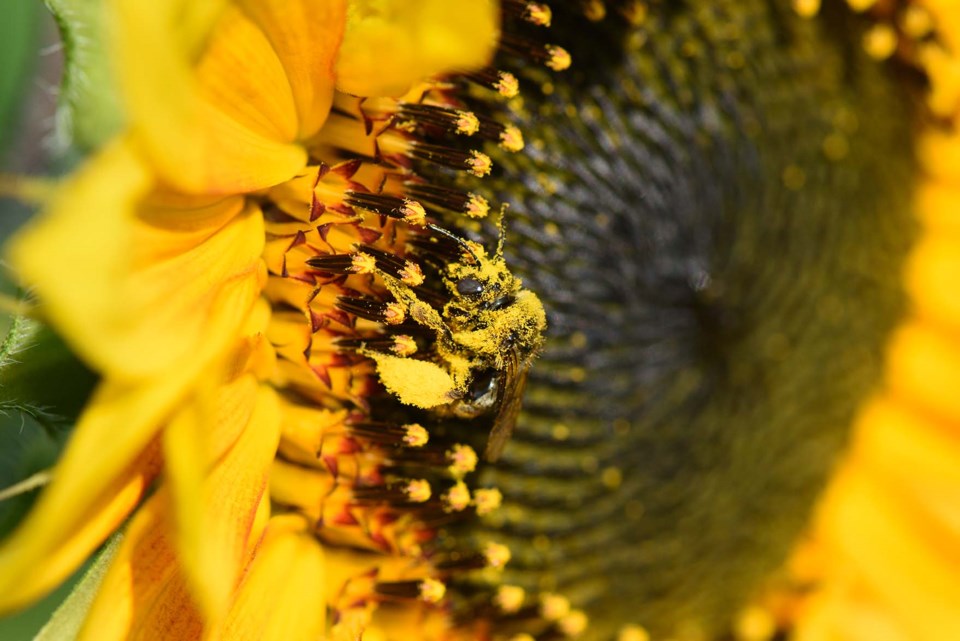Neighbours for climate
The Gazette is using the City of Edmonton’s Neighbouring for Climate guide to help St. Albert streets fight back against climate change. Check out the guide at edmonton.ca/climateneighbours.
Lawns are dumb. They’re big empty monocultures that do nothing but look green and bland, all while sucking up water, leaching pollution, and forcing kids to inhale lawnmower exhaust.
That’s why I was overjoyed to hear St. Albert city council pass a motion last Oct. 3 calling for new rules to ensure residents could create food crops, pollinator gardens, rain gardens, and xeriscaped landscapes in their front and side yards. These lawn alternatives can improve the health of the environment and your pocketbook and help prepare your street for global heating.
Lawns are not an environmentally friendly use of your front yard, said St. Albert Seed Library co-founder Dale Ford, who has turned her front yard into a registered pollinator garden. Lawns need plenty of water, fertilizer, and fossil fuels to maintain, and are composed entirely of non-native plants. (Kentucky Bluegrass, a common lawn grass, is a serious threat to native grasses in parts of North America.)
“They sit there and do nothing,” Ford said.
“You can’t even eat it.”
Better than lawns
The Neighbouring for Climate guide says planting a vegetable garden can help you save money, eat healthier, cut carbon emissions, and reduce packaging waste.
Professional horticulturalist Jim Hole said he grows plenty of vegetables in his yard and enjoys cheap, fresh carrots all winter. Growing your own food saves you money and reduces transportation-related pollution.
“You can grow the varieties that you want that are tasty,” he continued, and avoid importing crops from drought-prone regions in the U.S.
“A good portion of the water you consume is from California” in the form of vegetables, Hole said.
“Why not utilize the water that comes free from the sky here?”
Hole advised gardeners looking to replace their grass with food to start with a few raised containers to see if they like the change. Talk with your neighbours about your plans, and maybe steer away from messier or labour-intensive crops like wheat and potatoes. You can even co-ordinate what you grow with others on your street to create a spread-out community garden.
Pollinators such as bees, bats, and beetles support the plants that produce one out of every three bites of our food, the Pollinator Partnership notes. Pollinator gardens provide pollinators with flowering plants for food and shelter and enhance local biodiversity, Neighbouring for Climate reports.
Ford said pollinator gardens are a great partner for food gardens, the crops in which often need pollination. They also save you time, money, and fuel.
“I don’t have a sprinkler on my lawn ever,” Ford said, and she only has to mow it twice a year.
Ford’s pollinator garden features flowering and edible plants and a large patch of clover. She advised anyone looking to start a pollinator garden to stick to native plants that provide nectar (such as borage) and give insects easy access to their pollen (such as sunflowers). Bunch your plants up to give pollinators places to hide, and don’t use pesticides, as those kill beneficial insects.
Always make sure something is in bloom so the pollinators have food to eat, Ford and Hole added. The City of Edmonton has charts that show when different native plants bloom and the colours they produce. You might also want to leave some bare ground, as many native bees nest underground.
Rain gardens are less about plants and more about terrain, Ford and Hole explained. Instead of letting rain wash pollutants off your lawn, rain gardens channel water into natural and constructed depressions full of plants to absorb runoff. This can be as simple as pointing your downspout at a low point in your yard and planting water-hungry plants around it.
Xeriscaping involves planting drought-tolerant plants such as yucca or hens and chicks, Hole said. These plants will save you plenty of water and can help starve out water-loving weeds.
Getting started
The fall is a good time to start planning a replacement for your grassy lawn, Ford said. Start talking with your neighbours about it, and consider planting native seeds and spreading compost. Be sure to let those fall leaves lie on your lawn, as they will fertilize your yard and shelter pollinators during the winter. The St. Albert Seed Library and Edmonton Native Plant Society offer many free talks and resources on how to set up pollinator gardens.
Front-yard gardening can help bring your community together. Ford said her flowers get a lot of interest from her neighbours, and that she enjoys showing local kids the different berries growing in her yard.
“No one comes out and talks to you when you’re cutting your grass,” she noted.




